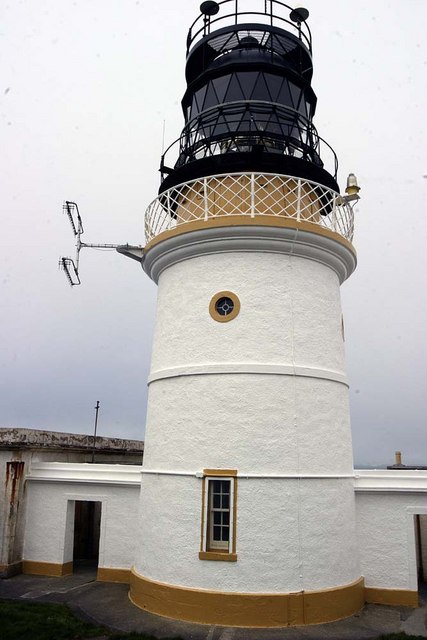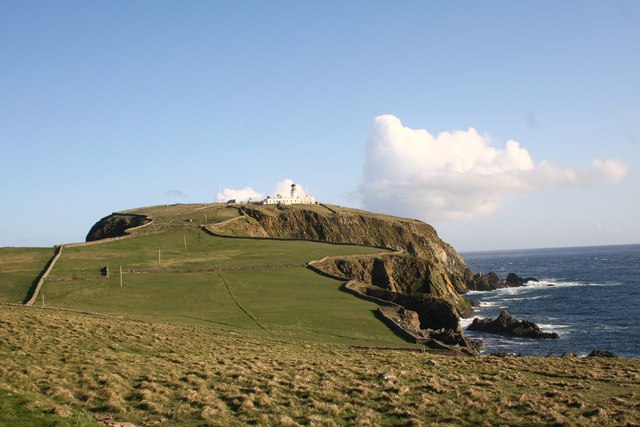Sumburgh Head Lighthouse
Shetland Isles
|

Location Guide |
|
This is the oldest Shetland Lighthouse.
Sumburgh Lighthouse is perched on a
headland at the most southerly tip of the mainland of Shetland, not far from Sumburgh Airport.
It dominates the landscape and seascape for miles around.
The area around the light station is a reserve
managed by the RSPB and their office is located in one of the
keeper's houses.
The Lighthouse dating from 1821, was the first lighthouse to be
built in Shetland, and was constructed by Robert Stevenson, grandfather of
the famous author Robert Louis Stevenson.
It was built with walls of double thickness to keep out
the damp. It also had 26 reflectors instead of the normal 21, and it was
commented by visitors to the light in 1823, 'everything is so exceedingly
clean and bright that the eye get dazed by the reflection'. The annual cost
of running and maintaining this light in 1822 was £650,000.
The most serious offence of a lighthouse keeper was to
fall asleep on watch, as the light may go out and this could have serious
repercussions. 15 cases of 'falling asleep' that were recorded, took place
in the second half of the 19th century at this lighthouse. The worst case
was in 1871 where two light keepers agreed not to report the other for
sleeping, one of which was a Principal Light keeper with 23 years service
and who should have known better. They were both dismissed on this occasion.
It was automated in 1991 and the
keepers
|

 Photo by David
White
Photo by David
White
 |
left. The houses and outbuildings now belong to the Shetland
Amenity Trust, and some have been converted into
holiday accommodation.
The Northern Lighthouse Board own the tower
and run the light, but the
Shetland Amenity Trust own the site. In February 2008 the Shetland
Amenity Trust announced that it would spend £1.5 million to restore the
lighthouse and provide a visitor centre, improve road access, and
additional accommodation. These improvements were assisted by a grant
of £683,000 from the Heritage Lottery Fund in October 2009.
Sumburgh Head is the most northerly transmitting station for
the Marine differential GPS Service (DGPS), a satellite based navigation
system.

Approaching the Lighthouse at Sumburgh Head
 Photo by
Andrew
Wood
Photo by
Andrew
Wood

The lighthouse sits on the site of an ancient fort, above
Sumburgh Head,
 an RSPB reserve,
which is home to over 15,000 seabirds in the summer months,
including 2,000 Puffins, Guillemots, Razorbills, Kittiwakes and Shags. It is
also home to 13,000 gannets and 1,000 fulmars. It migrant birds also visit during the spring and autumn migration periods and
it has a
reputation as a whale-watching site. Shetland has long hours of summer
daylight so more time to see and watch the wildlife.
an RSPB reserve,
which is home to over 15,000 seabirds in the summer months,
including 2,000 Puffins, Guillemots, Razorbills, Kittiwakes and Shags. It is
also home to 13,000 gannets and 1,000 fulmars. It migrant birds also visit during the spring and autumn migration periods and
it has a
reputation as a whale-watching site. Shetland has long hours of summer
daylight so more time to see and watch the wildlife.
|
Lighthouse information Grid
|

|
Please let us know any other information that we
can add to the Grid or page and any errors that you discover. Before making a long trip to any location it is always
wise to double check the current information, websites like magazines may be
correct at the time the information is written, but things change and it is of
course impossible to double check all entries on a regular basis. If you have
any good photographs that you feel would improve the illustration of this page
then please let us have copies. In referring to this page it is helpful if you
quote both the Page Ref and Topic or Section references from the Grid below. To print the
planning grid select it then right click and print the selected area.
Please submit information on locations you discover so
that this system continues to grow.
|